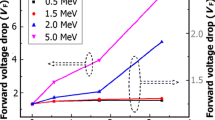Abstract
At high temperature, infra-red focal plane arrays are limited by their performance in operability, detectivity D * or noise equivalent temperature difference. Trap characterization and defect studies are necessary to better understand these limitations at high temperature. In this paper, we use deep level transient spectroscopy to study electrically active defects in mercury cadmium telluride n +/p diodes. The material investigated has a cut-off frequency (λ c) of 2.5 μm at 180 K and p doping performed with mercury vacancy. Trap energy signatures as well as capture cross-section measurements are detailed. A low temperature hole trap close to midgap is observed in the range 150–200 K with an activation energy around 0.18 ± 0.025 eV. A high temperature hole trap is also observed in the range 240–300 K with an activation energy of 0.68 ± 0.06 eV. A hole capture cross-section of 10−19 cm2 is obtained for both traps. The nature of the defects and their correlation with dark current are discussed.
Similar content being viewed by others
References
D.V. Lang, J. Appl. Phys. 45, 3022 (1974).
S.D. Brotherton and P. Bradley, J. Appl. Phys. 53, 5720 (1982).
L. Dobaczewski, K. Koscinski, K. Bonde Nielsen, A. Nylandsted Larsen, J. Lundsgaard Hansen, and A.R. Peaker, Phys. Rev. Lett. 83, 4582 (1999).
F.D. Auret and M. Nel, Appl. Phys. Lett. 48, 130 (1986).
D.L. Polla and C.E. Jones, J. Appl. Phys. 52, 5118 (1981).
D.L. Polla, M.B. Reine, and C.E. Jones, J. Appl. Phys. 52, 5132 (1981).
K. Ikeda and H. Takoaka, Jpn. J. Appl. Phys. 21, 462 (1982).
S. Weiss and R. Kassing, Solid State Electron. 31, 1733 (1988).
A.A. Istratov, O.F. Vyvenko, H. Hieslmair, and E.R. Weber, Meas. Sci. Technol. 9, 477 (1998).
L. Dobaczewski, K. Koscinski, I.D. Hawkins, and A.R. Peaker, J. Appl. Phys. 76, 194 (1994).
W.C. Johnson and P.T. Panousis, IEEE Trans. Electron. Devices 18, 965 (1971).
P.I. Rocket and A.R. Peaker, Electron. Lett. 17, 838 (1981).
J.A. Van Vechten and C.D. Thurmond, Phys. Rev. B 14, 3529 (1976).
M.A. Kinch, F. Agariden, D. Chandra, P.K. Liao, H.F. Schaake, and H.D. Shih, J. Electron. Mater. 34, 880 (2005).
M. Lax, Phys. Rev. 119, 1502 (1960).
Author information
Authors and Affiliations
Corresponding author
Rights and permissions
About this article
Cite this article
Rubaldo, L., Brunner, A., Berthoz, J. et al. Defects Study in Hg x Cd1−x Te Infrared Photodetectors by Deep Level Transient Spectroscopy. J. Electron. Mater. 43, 3065–3069 (2014). https://doi.org/10.1007/s11664-014-3226-y
Received:
Accepted:
Published:
Issue Date:
DOI: https://doi.org/10.1007/s11664-014-3226-y




